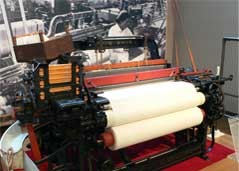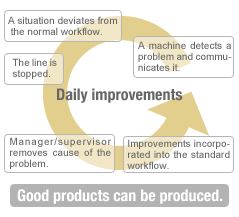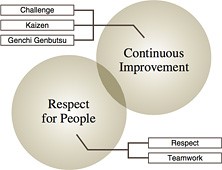The history of lean and kanban is a challenge to boil down, so inevitably, I know there are aspects that are missing here. The title says “short” because, while there is a lot of information here, it is short in terms of how more is out there! Additionally, there are often disagreements on certain aspects and points around the history, and we’ve sourced the various elements included in this outline. A key part of understanding kanban is going beyond the principles and practices, to understand what is behind it work. The history points us to a critical key.

The Type-G Toyoda Automatic Loom, the world’s first automatic loom with a non-stop shuttle-change motion, was invented by Sakichi Toyoda in 1924. This loom automatically stopped when it detected a problem such as thread breakage. 2
1920s: Sakichi Toyoda starts Automatic Loom Works, selling sophisticated automatic looms based on his years of inventing and improving looms. One invention was a mechanism that stopped the loom when a thread broke. This evolved into a key pillar in the Toyota Production
System, called jidoka or automation with a human touch. The term means building in quality or mistake proofing as you produce work. This loom was sold in 1929, and the money was used to found Toyota Motor Corporation. 1,2,4

1940s – With post war inflation, Toyota Motor Corporation struggled. They did voluntary cuts for managers and a 10% pay cut for all employees, to avoid bankruptcy. It was not enough, so they asked 1,600 workers to “retire” voluntarily.
This was contradictory to Toyoda’s policy of never firing an employee. The results were production issues and public demonstrations. Kiichiro Toyoda, did not sell off the company, take a large bonus, or blame others – he took responsibility and resigned as president. This helped improve worker satisfaction, but the bigger lesson here was leading by example and thinking beyond yourself.3
1950s – Taiichi Ohno, a production manager and former Toyota vice president, was asked by his boss, Eiji Toyoda, to improve Toyota’s manufacturing process, in order to compete with Ford (after Eiji toured a Ford plant). Taiichi and his team visiting US manufacturing plans and realized that these systems had a lot of waste. Additionally, Toyota did not have the sales revenue or funds to do massive economies of scale (which these realized were inefficient). They found problems throughout the process (“rewarding managers who cranked out tons of parts and kept workers and machines busy”, “large amounts of materials in inventory”, “a focus on cost per piece”, and “hidden defects in these large batches that could go undiscovered for weeks”).
He and his team pulled ideas from Ford (many of which Ford did not practice), as well as the concept of a pull-system, inspired by American supermarkets. Supermarkets use a pull-system, where customers “pull” items off the shelves, those items are restocked. So, the customer is driving the system, versus simply pushing more products onto full shelves. He was key to developing the Toyota Production system and created the basic framework for the just-in-time method. 5, 6
Taiichi Ohno is credited with creating the concept of a ‘kanban system’ which takes its name from the cards that signal when additional work is needed in a factory. As we know it today, kanban has become an approach to optimize the delivery of value by knowledge workers.
“All we are doing is looking at the time line from the moment the customer gives us an order to the point when we collect the cash. And we are reducing that time line by removing the non-value -added wastes.” Source: Taiichi Ohno, founder of TPS, 1988; via the Toyota Way
Toyota Production System (TPS) Today
The Toyota Production System (TPS), known as lean, lean production, and even ‘kanban’, is the system that Toyota has used to consistently improve their systems. TPS is used to deliver high-quality, adapt quickly, and create one of the top automotive companies in the world.
“Toyota Motor Corporation’s vehicle production system is a way of “making things” that is sometimes referred to as a “lean manufacturing system” or a “Just-in-Time (JIT) system,” and has come to be well known and studied worldwide.”1
This production control system has been established based on many years of continuous improvements, with the objective of “making the vehicles ordered by customers in the quickest and most efficient way, in order to deliver the vehicles as quickly as possible.”
The Toyota Production System (TPS) was established based on two concepts: The first is called jidoka (loosely translates “automation with a human touch”). In practice, jidoka means that when a problem occurs, the equipment stops immediately, preventing defective products from being produced. The second is the concept of “Just-in-Time,” in which each process produces only what is needed by the next process in a continuous flow.
Based on the basic philosophies of jidoka and Just-in-Time, the TPS can efficiently and quickly produce vehicles of sound quality, one at a time, that fully satisfy customer requirements.”7
1984 – Eli Goldratt published The Goal, explaining The Theory of Constraints. The Theory highlights the idea that there is one thing constraining the flow of value in a system and it needs to be targeted and fixed before then identifying the next constraint. The Theory of Constraints and the surrounding concepts, like the Five Focusing Steps are all improving flow.
1990 – The Machine that Changed the World was published by James P. Womack, Daniel T Jones, and Daniel Roos. “[When it was] published in 1990, Toyota was half the size of General Motors. [This was] the first book to reveal Toyota’s lean production system that is the basis for its enduring success. Now reissued with a new Foreword and Afterword, [the book] contrasts two fundamentally different business systems – lean versus mass, two very different ways of thinking about how humans work together to create value. Based on the largest and most thorough study ever undertaken of any industry – MIT’s five-year, fourteen-country International Motor Vehicle Program – this book describes the entire managerial system of lean production.”10

2001 – Toyota summarizes its philosophy in a set of principles and two key areas in, The Toyota Way 2001. “The Toyota Way is supported by two main pillars: ‘Continuous Improvement’ and ‘Respect for People’.
We are never satisfied with where we are and always work to improve our business by putting forward new ideas and working to the best of our abilities. We respect all Toyota stakeholders, and believe the success of our business is created by individual effort and good teamwork.” 8
2001 – Agile Manifesto was created.9
2003 – Lean Software Development was published by Mary and Tom Poppendieck (as well as the subsequent books, Implementing Lean Software Development (2007), Leading Lean Software Development (2009)). The entire series looks at the application of lean in relation to software development. We see the application of many of these ideas applying to the development of any kind of products or services in the knowledge workspace, not just software – or as we put it, “doing complex stuff.”
2004 – The Toyota Way is published by Jeffrey Liker, explaining the Toyota Production System (TPS) and the management principles that allow it to succeed. The booked covers key aspects of TPSs success, including long-term philosophy, the right process will produce the right results, add value to the organization by developing your people and partners, and continuously solving root problems drives organizational learning.
2010 – David Anderson published ‘Kanban – Successful Evolutionary Change for Your Technology Business’, introducing kanban for knowledge work. [Our view is that] David’s work pulled from the best of many concepts including Toyota, lean, TPS, and management professionals like Peter Drucker to build on it. The Kanban Method describes kanban systems to support incremental and evolutionary change for organizations performing knowledge work. In his work, David presents the recipe for change, later known as STATIK, the Systems Thinking Approach To Introducing Kanban, to help others use kanban for positive change in their organizations.
Kanban Today – Kanban, as it’s known today in the agile space, is the application of lean concepts and kanban systems, by people and teams, to optimize the flow of value to your customers.
In Summary
Kanban’s history is critical to understanding what needs to happen for kanban to work. As you read about the history, you can see the impact of decisions made by leaders to the culture. You can see not just the stated policy, but the principle of respecting people and creating an environment where they are empowered to act (remember that telling people “you are empowered” generally does the opposite). Remember, culture can’t be turned on or installed, it is what exists based on the how everyone in the organization collectively engages, collaborates, and makes decisions.
This is a core foundation of our Leading Amazing Teams Training – where we dive deep into the approaches and engagement options leaders have to help create and maintain high-performance teams at all levels of the organization. You may also see how the aspects of the history are represented in What is Kanban? and Kanban Principles for Success (if you have not read them, check them out if you liked this article). Ultimately, kanban is about creating an environment where people can contribute, thrive, and improve – a lot of approaches have that goal – kanban actually gives you a shot at achieving it.
Ask Yourself
Want to dig deeper? Ask yourself some of these questions as you think about the history of kanban:
- What stories exist in your organization that support a culture that aligns with kanban?
- What stories exist in your organization that don’t?
- What behaviors are exhibited within your organization that align or don’t with kanban?
- What behaviors do you exhibit that align or don’t?
Feel free to contribute thoughts, questions, flames, and disagreements in the comments section.
This article is derived from an exercise used in Agile with Kanban training workshop.
Footnotes: 1. The Toyota Way by Jeffrey Liker p16-17 2. Toyota Production System: Jidoka 3. Origin of Toyota Production System 4. The Toyota Way by Jeffrey Liker p18-19 5. The Toyota Way by Jeffrey Liker p22-23 6. Toyota Production System: Just in Time 7. Toyota Production System 8. Toyota Way 2001 9. Agile Manifesto 10. Lean.org book review










